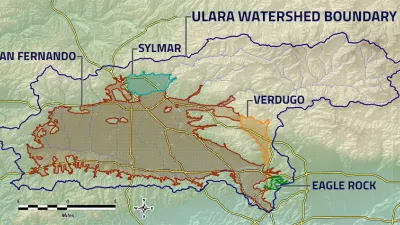Harsh climate and persistent drought have accelerated New Mexico's desertification over three years of record-breaking heat. With 87% of the Western U.S. experiencing a drought, is New Mexico the canary in the coal mine for an increasingly arid area?
With fall fast approaching, intolerable heat waves and parched summer weather will soon be a thing of the past across much of the U.S. But for New Mexico, no such relief appears to be in sight.
With the entire state in a drought, ecosystems are collapsing, reservoirs are at 17% of normal, livestock levels and crop yields are way down, and the once-mighty Rio Grande has been cynically nicknamed the ‘Rio Sand’. “[T]he question is no longer how much worse it can get but whether it will ever get better,” writes Julie Curt, “and, ominously, whether collapsing ecosystems can recover even if it does.”
Are these scorched weather conditions part of New Mexico's new norm? Meteorologist Chuck Jones claims that “even the state's recent above-average monsoon rains 'won't make a dent' in the drought.” Nonetheless, Jones hesitates to identify the past three years of extreme drought as a permanent climate change, rather than a 'multiyear aberration'.
Perhaps most concerning are the changes taking place in the 140,000-square-mile Chihuahuan Desert. Curt explains, “[f]ederal scientists are grimly watching a rare ecological phenomenon unfold here, a catastrophic alteration known as ‘state change’ — the collapse of the vast Chihuahuan Desert grasslands ecosystem and its transformation into a sandy, scrub desert affording little forage for wildlife or livestock.”
“As vegetation dies off and the process of desertification accelerates, [landscape ecologist Brandon] Bestelmeyer said, the Chihuahuan Desert will expand. As Western cities continue their march into wildlands, the growing desert and the sprawling suburbs are on a collision course.”
FULL STORY: New Mexico is the driest of the dry

Planetizen Federal Action Tracker
A weekly monitor of how Trump’s orders and actions are impacting planners and planning in America.

San Francisco's School District Spent $105M To Build Affordable Housing for Teachers — And That's Just the Beginning
SFUSD joins a growing list of school districts using their land holdings to address housing affordability challenges faced by their own employees.

The Tiny, Adorable $7,000 Car Turning Japan Onto EVs
The single seat Mibot charges from a regular plug as quickly as an iPad, and is about half the price of an average EV.

Seattle's Plan for Adopting Driverless Cars
Equity, safety, accessibility and affordability are front of mind as the city prepares for robotaxis and other autonomous vehicles.

As Trump Phases Out FEMA, Is It Time to Flee the Floodplains?
With less federal funding available for disaster relief efforts, the need to relocate at-risk communities is more urgent than ever.

With Protected Lanes, 460% More People Commute by Bike
For those needing more ammo, more data proving what we already knew is here.
Urban Design for Planners 1: Software Tools
This six-course series explores essential urban design concepts using open source software and equips planners with the tools they need to participate fully in the urban design process.
Planning for Universal Design
Learn the tools for implementing Universal Design in planning regulations.
Smith Gee Studio
City of Charlotte
City of Camden Redevelopment Agency
City of Astoria
Transportation Research & Education Center (TREC) at Portland State University
US High Speed Rail Association
City of Camden Redevelopment Agency
Municipality of Princeton (NJ)





























